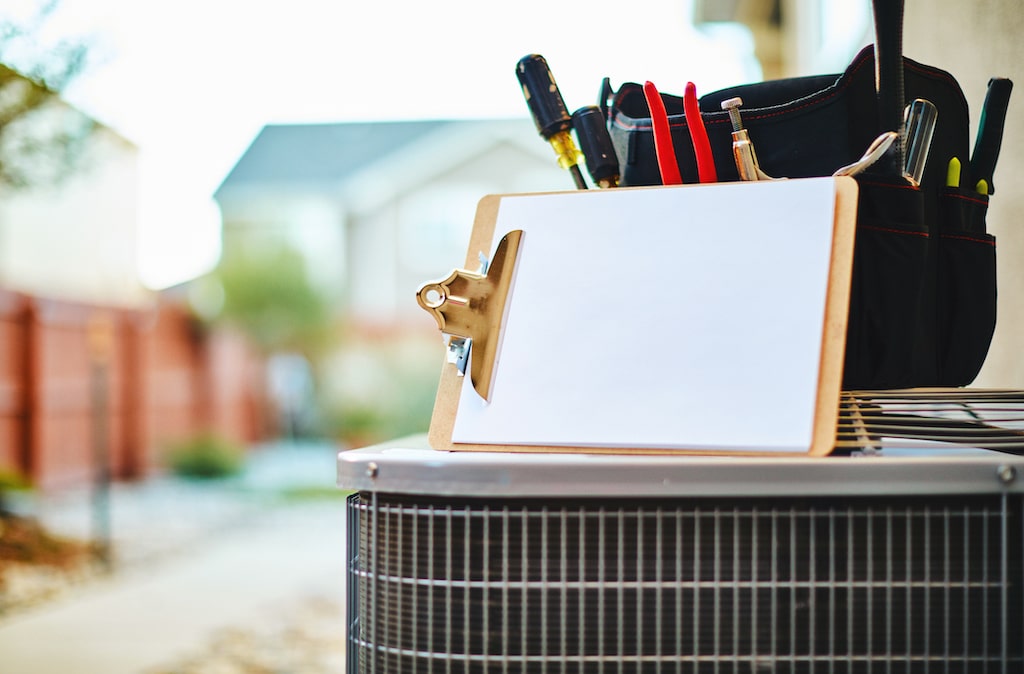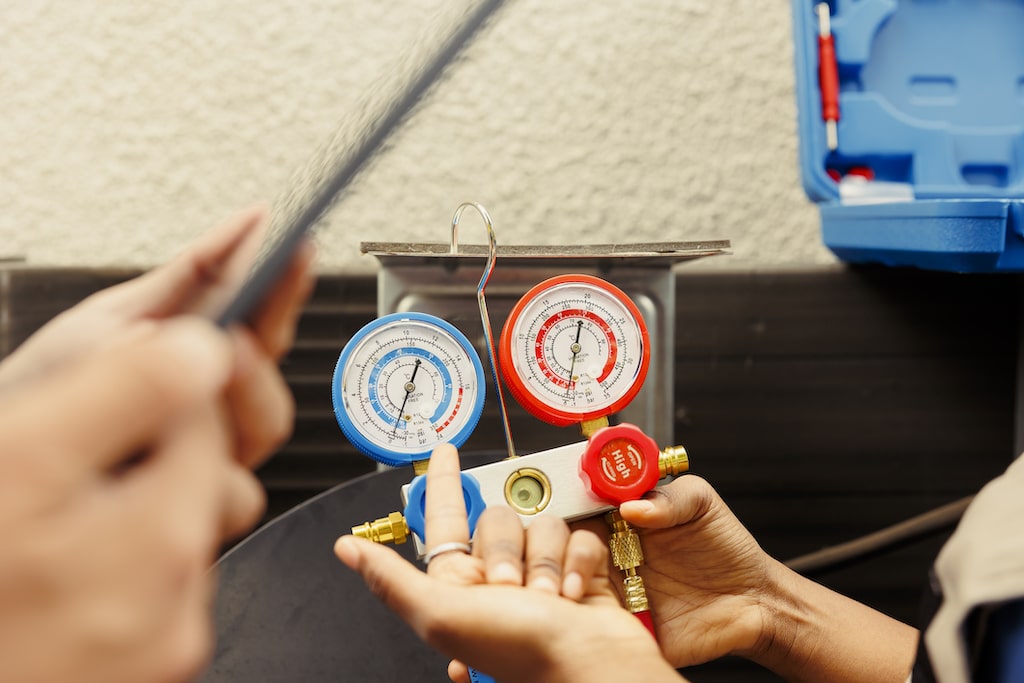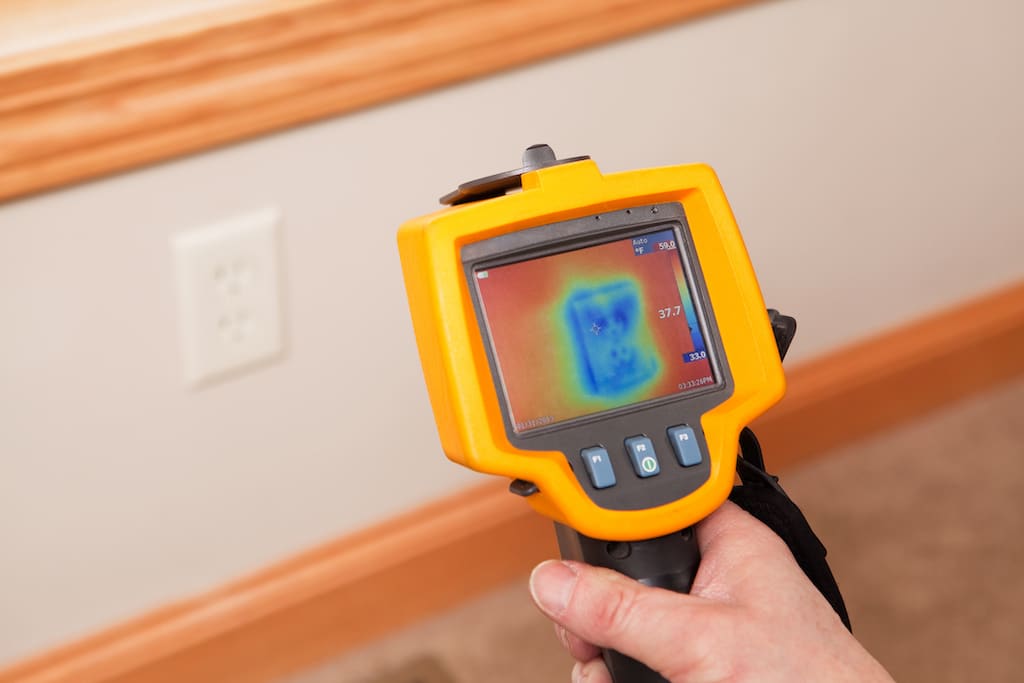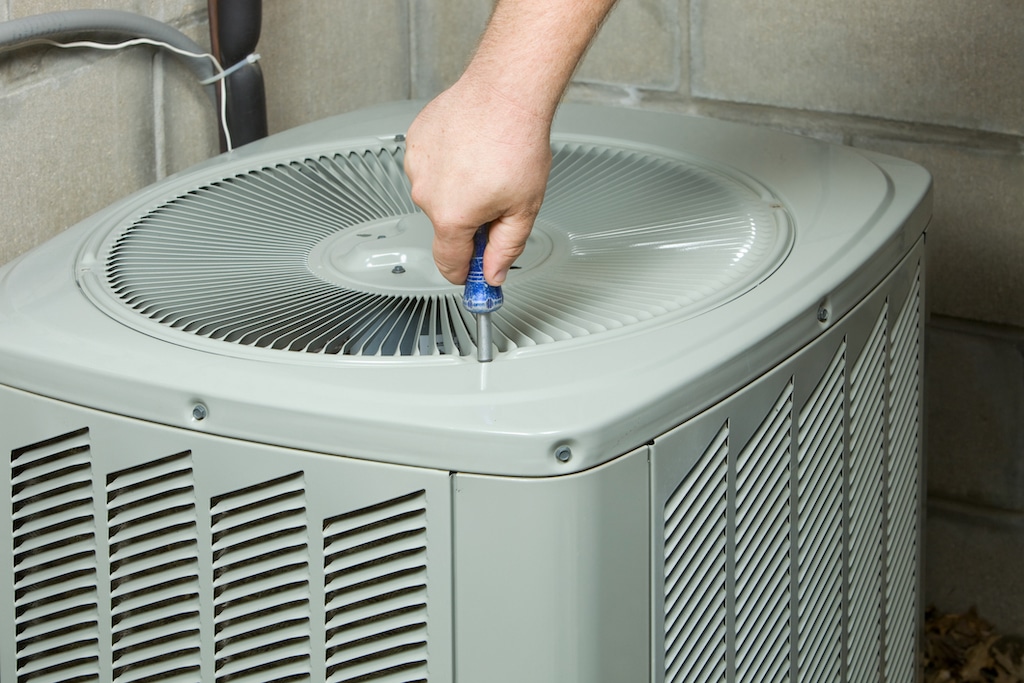
AC Repair: The Ultimate Guide to Keeping Your Home Cooler and Comfortable
Ever found yourself sweating on a hot summer day, wondering why your air conditioner isn’t working?
As a homeowner, you’ve probably faced the daunting task of dealing with a malfunctioning AC unit. Understanding AC repair is crucial for those unexpected moments when the cool breeze stops.
In this article, we’ll dive deep into the world of AC repair. From understanding the basics to troubleshooting common problems, and even exploring top tips from experts, we’ve got you covered.
Let’s embark on this cool journey together.
A Detailed Explanation of AC Repair
What is AC Repair?
AC repair is the process of diagnosing, fixing, and ensuring the optimal functioning of an air conditioning unit.
It encompasses a range of activities, from simple filter changes to more complex component replacements. Understanding AC repair is essential for every homeowner, especially during those hot summer months when a functioning AC is not just a luxury but a necessity.
The Intricacies of an Air Conditioner
Air conditioners, often referred to simply as ACs, are more than just machines that blow cold air. They are intricate systems designed to regulate both temperature and humidity, ensuring a comfortable environment in our homes and offices.
At the heart of an AC is a refrigeration cycle, which involves the conversion of a refrigerant between gas and liquid to cool the air.
There are several components involved, including the compressor, condenser, expansion valve, and evaporator coil.
Each of these plays a crucial role, and if one malfunctions, it can affect the entire system. Understanding the intricacies of an AC is the first step in grasping the importance of AC repair.
Also read: Stay Cool & Informed: Your Comprehensive Dive Into Air Conditioning Service Excellence
The Importance of Timely AC Repair
Delaying AC repair can lead to more significant problems down the line.
A minor issue today can become a major one tomorrow, leading to more expensive repairs or even the need for a complete replacement. But it’s not just about the money.
A malfunctioning AC can:
The Impact of Inefficient AC Units on Energy Bills
When it comes to AC maintenance and repair, one of the most tangible effects of an inefficient air conditioning unit is the surge in energy bills.
An air conditioner’s primary function is to maintain a comfortable indoor temperature, but when it’s not operating at its peak efficiency, it struggles to achieve this goal.
As a result, the system has to run longer and work harder, leading to increased energy consumption.
The reasons for an AC becoming inefficient can vary.
It could be due to clogged filters restricting airflow, refrigerant leaks affecting the cooling capacity, or even worn-out components causing the system to overexert.
Each of these issues forces the AC to expend more energy to produce the same cooling effect, leading to higher electricity consumption.
For homeowners, this inefficiency translates directly to higher monthly energy bills. Over time, these added costs can accumulate, making it an expensive oversight.
Moreover, an overworked AC system not only consumes more power but also faces a higher risk of breakdowns and wear and tear, potentially leading to more frequent and costly AC repairs.
In essence, ensuring your AC unit’s efficiency is not just about comfort; it’s also about economic prudence.
Regular maintenance and timely AC repair can help maintain the system’s efficiency, ensuring optimal performance while keeping energy bills in check.
The Detrimental Effects of a Malfunctioning AC on Air Quality
Air quality within our homes and workplaces is crucial for overall well-being, and a significant contributor to maintaining this is a well-functioning air conditioning unit.
However, when it comes to AC repair, a malfunctioning or broken AC can have adverse effects on the indoor air quality, often going unnoticed until health issues arise.
A compromised AC system can lead to inadequate air circulation. Without proper airflow, the indoor environment can become stagnant, creating a conducive environment for mold growth.
Mold spores, once airborne, can be inhaled, leading to respiratory issues, allergies, and other health concerns. Moreover, mold can produce a musty odor, making the living or working space unpleasant.
In addition to mold, a malfunctioning AC can also lead to an increase in allergens. Dust, pollen, and other airborne particles, instead of being filtered out, can accumulate and get recirculated.
For individuals with allergies or respiratory conditions, this can exacerbate their symptoms, leading to frequent sneezing, coughing, and even asthma attacks.
In the broader context of AC repair, ensuring that the unit is functioning optimally is not just about maintaining a comfortable temperature.
It’s also about safeguarding the health of the occupants by ensuring clean, fresh, and allergen-free air. Regular maintenance, timely repairs, and filter replacements are essential steps in ensuring that the air we breathe indoors is of the highest quality.
The Unbearable Discomfort of a Non-Functioning AC During Peak Summer
The importance of a well-functioning air conditioning unit, especially during the sweltering summer months, cannot be overstated.
When it comes to AC repair, the consequences of a malfunctioning or entirely broken AC extend beyond mere inconvenience. It directly impacts our comfort, well-being, and even our daily routines.
During peak summer, temperatures can soar, making indoor spaces feel like ovens. A functioning AC provides a much-needed respite from this intense heat, ensuring a comfortable and conducive environment, whether it’s for relaxation at home or productivity at work.
However, when the AC fails, the indoor temperature can quickly become unbearable. The stifling heat can make it challenging to focus, sleep, or even perform basic tasks.
Moreover, the discomfort isn’t just about the heat.
High temperatures combined with humidity can lead to excessive sweating, dehydration, and even heat-related illnesses.
For vulnerable groups, like the elderly, children, or those with certain medical conditions, living without a functioning AC during summer can pose significant health risks.
In the realm of AC repair, ensuring that the unit is in optimal condition is not just about machinery; it’s about human comfort and safety.
A timely intervention, be it a simple maintenance check or a more complex repair, can make the difference between a summer of discomfort and one of relaxation and ease.
The Health Implications of Extreme Temperatures and the Role of AC Repair
The significance of a fully operational air conditioning unit extends far beyond mere comfort.
In the context of AC repair, a malfunctioning system can have direct health repercussions, especially when extreme temperatures come into play. The vulnerability of certain groups, notably the elderly and young children, to these temperature fluctuations makes the issue even more pressing.
Extreme temperatures, whether sweltering heat or freezing cold, can strain the human body.
In scorching conditions, the body works overtime to cool down, leading to excessive sweating and potential dehydration. If not addressed, this can escalate to heat exhaustion or even heat stroke, both of which can be life-threatening.
The elderly, whose bodies might not regulate temperature as efficiently, and young children, who might not recognize the signs of heat-related illnesses, are particularly at risk.
Conversely, in extremely cold conditions, without a functioning heating system, risks like hypothermia become real concerns.
Again, vulnerable groups like the elderly, whose bodies might not produce adequate heat, or young children, who lose body heat more quickly, are especially susceptible.
Recognizing the importance of timely AC repair ensures not just a comfortable living environment but also the well-being of your loved ones.
DIY vs. Professional AC Repair
While some minor AC issues can be addressed with a DIY approach, it’s essential to know when to call in the professionals.
Changing filters, cleaning the exterior unit, or even resetting a tripped circuit breaker are tasks you might handle yourself.
However, when it comes to refrigerant leaks, electrical issues, or internal component malfunctions, it’s best to rely on professional expertise. Not only do they have the necessary tools and knowledge, but they also ensure the safety and longevity of your AC unit.
The Long-Term Benefits of Regular Maintenance
While AC repair is crucial, prevention is always better than cure.
Regular maintenance can identify potential issues before they become significant problems. This includes cleaning, checking for leaks, ensuring all components are functioning correctly, and replacing worn-out parts.
Regular maintenance not only prolongs the life of your AC but also ensures it runs efficiently, saving you money on energy bills.
AC repair is not just about fixing a machine; it’s about ensuring a comfortable, healthy living environment.
Whether you’re facing minor issues or significant malfunctions, understanding the importance of timely repair and maintenance can save you time, money, and a lot of discomforts.
Also read: Mastering The World Of Heating And Ac Repair: A Comprehensive Guide

Photo By Dragos Condrea at iStock
Understanding the Basics
The Anatomy of an Air Conditioning Unit
When we talk about AC repair, it’s essential to first understand the anatomy of an air conditioning unit.
Just as the human body comprises various organs, each with its function, an AC unit consists of several components that work in tandem to provide cooling.
The main components include:
The Compressor: The Vital Heartbeat in AC Repair and Functionality
In the intricate world of AC repair and maintenance, understanding the role of each component is paramount.
Among these components, the compressor stands out as one of the most critical parts of an air conditioning system. Often referred to as the heart of the AC, its function and importance cannot be overstated.
The compressor’s primary role is to pressurize the refrigerant, a crucial substance in the cooling process.
By doing so, it transforms the refrigerant from a low-pressure gas into a high-temperature gas. This pressurized, high-temperature gas then travels to the condenser coils, where it releases its heat and cools down, eventually turning back into a liquid form.
This cycle of compression and decompression is what allows the AC to absorb heat from inside a room and release it outside, providing a cool and comfortable indoor environment.
However, like any heart, the compressor needs to be in optimal condition to ensure the entire system functions efficiently.
Any malfunction or inefficiency in the compressor can lead to a cascade of issues in the AC unit. In the realm of AC repair, addressing compressor issues promptly is crucial to prevent more extensive damage and ensure the longevity and efficiency of the system.
The Condenser Coil: A Crucial Component in AC Repair and System Efficiency
In the multifaceted domain of AC repair, each component plays a unique and vital role.
Among these, the condenser coil stands out as a pivotal element in ensuring the efficiency and functionality of the air conditioning system. Situated in the outdoor unit of the AC, the condenser coil performs a task that is both simple in concept but critical in execution.
The primary function of the condenser coil is to release the heat absorbed by the refrigerant from the indoor environment.
As the high-temperature gas from the compressor reaches the condenser coil, it begins to cool down.
Through this process, the heat from the refrigerant is dissipated into the outside air, and the refrigerant itself is converted back into a liquid form. This transformation is essential for the refrigerant to cycle back into the system and continue the cooling process.
However, for the condenser coil to function optimally, it needs to be free from dirt, debris, and any obstructions.
A dirty or clogged condenser coil can hinder the heat dissipation process, leading to reduced efficiency and potential system overheating. In the context of AC repair, regular cleaning and maintenance of the condenser coil are paramount to ensure the system’s longevity and optimal performance.
The Expansion Valve: A Key Regulator in AC Repair and System Operation
Within the intricate framework of AC maintenance and repair, understanding the nuanced roles of individual components is essential.
The expansion valve, though small in size, plays a monumental role in the overall functionality and efficiency of the air conditioning system.
The expansion valve’s primary duty is to regulate the flow of the refrigerant as it moves into the evaporator coil.
Acting as a gatekeeper, it controls the amount and rate at which the refrigerant enters, ensuring that it does so at the optimal pressure and temperature. By doing this, the expansion valve ensures that the refrigerant can absorb the maximum amount of heat from the indoor air as it passes through the evaporator coil.
A malfunctioning expansion valve can lead to a myriad of issues. If too much refrigerant flows into the evaporator coil, it can lead to inefficiencies and even potential freezing of the coil.
Conversely, too little refrigerant can result in inadequate cooling. In the realm of AC repair, ensuring the proper functioning of the expansion valve is crucial to maintain the system’s balance and efficiency.
The Evaporator Coil: An Essential Player in AC Repair and Indoor Cooling
Diving deep into the realm of AC repair and system dynamics, the evaporator coil emerges as a central figure in the cooling process.
Nestled within the indoor unit of the air conditioning system, this component might be out of sight, but its impact on indoor comfort is profound and undeniable.
The primary role of the evaporator coil is to absorb heat from the indoor environment.
As the refrigerant, now in a low-pressure liquid state due to the actions of the expansion valve, flows through the coil, it comes into contact with the warmer indoor air. This interaction causes the refrigerant to evaporate, absorbing the heat from the surrounding air in the process.
The result?
A cooler, more comfortable indoor atmosphere.
However, the efficiency of the evaporator coil is contingent on its condition. Over time, dust, dirt, and other debris can accumulate on the coil, hindering its ability to absorb heat effectively.
In the context of AC maintenance and repair, regular cleaning and maintenance of the evaporator coil are paramount to ensure optimal performance and prevent issues like reduced cooling or coil freezing.
Understanding these components is crucial for effective AC repair.
When one part malfunctions, it can impact the entire system’s performance.
Diagnosing the Problem: More Than Just Symptoms
In the realm of AC repair, symptoms like “it’s not cooling enough” or “it’s making a strange noise” are just the tip of the iceberg.
Delving deeper to find the root cause is essential. For instance:
- A non-cooling AC might be due to a refrigerant leak, a malfunctioning compressor, or even a simple thermostat setting issue.
- A noisy AC could be because of a loose belt, a failing motor, or debris inside the unit.
Just as a doctor wouldn’t prescribe medication based solely on symptoms without a proper diagnosis, an AC technician looks beyond the obvious to determine the actual problem.
The Importance of Accurate Diagnosis
An accurate diagnosis is the cornerstone of effective AC repair. Misdiagnosing an issue can lead to:
- Unnecessary Replacements: Replacing parts that are in good working condition can be costly and ineffective.
- Recurring Issues: If the root cause isn’t addressed, the problem can recur, leading to repeated repairs.
- Potential Damage: Incorrect repairs can cause further damage to the unit, reducing its lifespan.
Just as you’d seek a second opinion for a serious health diagnosis, it might be worth consulting another technician if you’re unsure about the recommended AC maintenance and repair.
Also read: Why Is Emergency Heating And Ac Repair Service Essential For You?

Photo By BanksPhotos at iStock
The Role of Technology in AC Repair
Modern AC repair goes beyond manual inspections. Technicians now use advanced tools and technology to diagnose issues accurately.
For instance:
Thermal Imaging Cameras in AC Repair
In the modern era of AC repair, advanced tools like thermal imaging cameras have become indispensable.
These cameras, equipped with the ability to detect temperature variations, offer a non-invasive method to diagnose issues within an air conditioning system.
By visualizing the temperature differences, technicians can swiftly pinpoint problems such as refrigerant leaks or blockages.
For instance, an area showing an unusually cold spot might indicate a refrigerant leak, while a hot spot could suggest a blockage or overworked component.
By leveraging the capabilities of thermal imaging cameras in AC repair, professionals can ensure more accurate diagnostics, leading to more efficient and effective solutions for maintaining optimal cooling performance.
Digital Multimeters in AC Repair: A Diagnostic Powerhouse
In the realm of AC repair, the importance of precise diagnostic tools cannot be overstated.
Enter digital multimeters, a technician’s trusted ally when it comes to identifying electrical issues within an air conditioning system. These versatile devices are designed to measure voltage, current, and resistance, providing a comprehensive insight into the electrical health of the unit.
Whether it’s a malfunctioning component or a wiring issue, digital multimeters can quickly and accurately detect the problem.
By ensuring that the electrical aspects of the AC are functioning correctly, these tools play a pivotal role in maintaining the system’s efficiency and longevity, safeguarding your comfort throughout the seasons.
Anemometers in AC Repair: Ensuring Optimal Air Circulation
Within the intricate landscape of AC repair, ensuring optimal air circulation is paramount for comfort and efficiency.
Anemometers, specialized tools designed to measure air flow, play a crucial role in this endeavor. By gauging the speed and volume of air being circulated by the air conditioning unit, these devices help technicians ascertain if the system is operating at its best.
A decline in air flow can indicate issues like clogged filters or malfunctioning fans.
By utilizing anemometers in AC repair, professionals can make informed decisions, ensuring that every room benefits from consistent and efficient cooling, enhancing overall indoor comfort.
Embracing technology ensures a more accurate diagnosis, leading to more effective repairs.
The Human Touch in AC Repair
While technology plays a significant role, the human touch is irreplaceable in AC maintenance and repair.
Experienced technicians can often identify issues based on subtle signs, from a slight humming sound to a faint odor. Their expertise, combined with a deep understanding of AC systems, ensures that your unit is not just repaired but restored to optimal performance.
Common AC Issues and Their Solutions
Refrigerant Leaks in AC Repair
One of the most common issues faced in the realm of AC repair is refrigerant leaks.
The refrigerant is a vital component of any air conditioning system. It’s the substance that circulates within the AC unit, absorbing heat from the indoor environment and releasing it outside, thereby cooling your home or office.
When your AC isn’t cooling as effectively as it should, a refrigerant leak is often a prime suspect.
So, what causes these leaks?
Over time, due to wear and tear, the coils that contain the refrigerant can develop tiny holes or cracks. These imperfections can lead to the refrigerant slowly escaping from the system.
Environmental factors, such as corrosion, especially in coastal areas where salt in the air can speed up the corrosion process, can also contribute to these leaks. Additionally, physical damage, improper installation, or factory defects can be culprits.
The implications of a refrigerant leak extend beyond just a warm living space.
Firstly, when the refrigerant level drops, the AC has to work harder to achieve the same cooling effect, leading to increased energy consumption and higher electricity bills. Over time, this can strain the system, reducing its lifespan.
Moreover, refrigerants are not environmentally friendly. When they leak into the atmosphere, they can contribute to greenhouse gas emissions, which play a role in global warming.
Addressing a refrigerant leak involves more than just topping up the refrigerant.
It’s crucial to first identify and seal the source of the leak. This often requires specialized equipment and expertise. Once the leak is sealed, the technician can then refill the refrigerant to the recommended level, ensuring optimal performance.
While a refrigerant leak might seem like a minor hiccup in the grand scheme of AC repair, it’s a problem that requires immediate attention.
Not only does it impact the efficiency and performance of your AC, but it also has broader environmental implications. As always, if you suspect a refrigerant leak, it’s best to consult a professional to ensure the issue is addressed correctly and safely.
Sensor Problems
In the intricate world of AC repair, understanding the role and function of sensors is paramount.
Modern air conditioning units are equipped with a plethora of sensors designed to optimize performance, ensure safety, and maximize energy efficiency.
One of the most critical sensors in an AC unit is the thermostat sensor. This sensor plays a pivotal role in ensuring that your living or working space maintains the desired temperature.
The thermostat sensor works by measuring the temperature of the air that flows into the evaporator coil. Based on this measurement, the AC unit adjusts its cooling output. If this sensor malfunctions or is not positioned correctly, it can lead to a myriad of issues.
For instance, your AC might start to cycle constantly, or it might not turn on at all. In other cases, you might find that the AC cools the room too much or not enough, leading to discomfort.
Several factors can lead to sensor problems.
Physical damage, wear and tear over time, or even manufacturing defects can result in a malfunctioning sensor. Dust and debris can also accumulate on the sensor, affecting its accuracy.
Furthermore, if the sensor is dislodged from its proper position, it can lead to erratic behavior of the AC unit.
Addressing sensor problems in AC repair often involves a thorough inspection. Technicians will check the sensor’s position, ensure it’s clean, and test its functionality. If the sensor is found to be faulty, it might need to be replaced.
However, in many cases, a simple recalibration or repositioning can resolve the issue.
In the broader context of AC repair, while issues like refrigerant leaks or compressor malfunctions might seem more pressing, sensor problems can be just as disruptive. They underscore the importance of regular maintenance and checks.
After all, in the sophisticated dance of AC components, every part, no matter how small, plays a crucial role.
If you ever notice irregularities in your AC’s cooling patterns or its overall behavior, it might be worth considering a sensor issue and seeking professional assistance.
Drainage Issues
In the comprehensive landscape of air conditioner repair, drainage issues often emerge as silent disruptors.
An air conditioning unit doesn’t just cool the air; it also plays a pivotal role in controlling humidity. As it cools the air, it extracts moisture, which then needs to be drained away.
This is where the condensate drain comes into play. However, like any other component, the drainage system can face challenges, leading to potential problems for homeowners.
The primary function of the condensate drain is to channel the moisture collected from the indoor air to the outside.
Over time, this drain can become clogged due to various reasons. Dust, dirt, mold, and even algae can accumulate, obstructing the free flow of water. When this happens, the water has nowhere to go and can start to back up.
The immediate consequence of a clogged condensate drain is water leakage. You might notice puddles of water around your indoor unit or even water stains on the walls or ceiling.
But the implications go beyond just a mess. Persistent moisture can lead to mold growth, which can have adverse health effects, especially for those with respiratory conditions.
Moreover, the excess water can damage the AC unit itself, as well as the surrounding structures, leading to costly repairs or replacements.
Addressing drainage issues in AC maintenance and repair is a multi-step process. The first step is to identify the blockage. Technicians will inspect the drain, often using cameras to get a clear view of the inside.
Once the blockage is located, it’s cleared using specialized tools. In some cases, the drain might also be treated with algaecides or other chemicals to prevent future blockages.
While drainage issues might seem minor in the grand scheme of AC repair, they can lead to significant disruptions and potential damage.
Regular maintenance, including cleaning the condensate drain, can prevent such problems.
If you ever notice signs of water leakage from your AC, it’s essential to address the issue promptly, ensuring the longevity of your unit and the comfort of your living space.
Why Regular Maintenance is Key
Extending the Lifespan of Your AC Unit
One of the primary benefits of regular maintenance in the realm of AC repair is the extension of your unit’s lifespan.
Just as regular check-ups can help maintain human health, consistent maintenance ensures that your AC unit remains in optimal condition for a more extended period. Over time, components of the AC, like fans, belts, and filters, can wear out.
By regularly checking and replacing these parts before they break down entirely, you can prevent more significant, more costly issues down the line. Moreover, by ensuring that all components are working efficiently, you reduce the strain on the system, leading to less wear and tear.
Think of it as changing the oil in your car; by addressing small issues regularly, you can prevent major breakdowns and extend the life of your vehicle.
Ensuring Optimal Performance and Efficiency
Another crucial aspect of regular maintenance is ensuring that your unit operates at its peak efficiency.
Over time, dust and debris can accumulate in various parts of the AC, from the filters to the condenser coils. This accumulation can hinder airflow and reduce the system’s efficiency.
By regularly cleaning and replacing these components, you ensure that your AC cools your space effectively, using the least amount of energy. This not only ensures a comfortable living environment but also translates to lower energy bills.
In essence, regular maintenance can save you money in the long run, both in terms of reduced repair costs and energy savings.
Preventing Costly Breakdowns and Repairs
Perhaps one of the most compelling reasons for regular maintenance in AC repair is the prevention of costly breakdowns.
Imagine your AC breaking down in the middle of a sweltering summer day. Not only do you have to deal with the discomfort, but emergency repairs can also be expensive.
Regular maintenance can identify potential issues before they become significant problems.
For instance, a technician might spot a refrigerant leak or a malfunctioning component during a routine check-up, allowing for timely intervention. By addressing these issues early, you can avoid the inconvenience and cost of a complete system breakdown.
Enhancing Air Quality and Health
Beyond cooling, an AC unit plays a crucial role in maintaining the air quality in your space.
Over time, mold, bacteria, and allergens can accumulate in the system, especially if the filters are not regularly replaced. This can lead to poor air quality, which can have adverse health effects, especially for those with respiratory conditions or allergies.
Regular maintenance ensures that these contaminants are removed, ensuring that the air you breathe is clean and healthy.
In essence, regular AC maintenance is not just about comfort; it’s also about health and well-being.
Peace of Mind for Homeowners
Lastly, regular maintenance offers homeowners peace of mind. Knowing that your AC unit is in optimal condition, free from potential issues, can be reassuring.
You can rest easy, knowing that the chances of unexpected breakdowns are minimized. Moreover, many AC manufacturers require regular maintenance as a condition for warranty claims.
By keeping up with regular check-ups, you ensure that your warranty remains valid, offering additional peace of mind.

Photo By BanksPhotos at iStock
Top 5 Tips and Strategies to Take Care of Your AC System
Air conditioning (AC) systems are essential for comfort, especially during hot seasons. Like any other appliance, they require attention to function optimally.
Here are five key strategies to ensure your AC system’s longevity and efficiency:
Regular Maintenance
Think of your AC as you would your vehicle. Just as cars need periodic servicing to run smoothly, so does your AC. Regular maintenance can thwart potential problems, ensuring your system operates at its best.
Monthly Filter Checks
Filters play a pivotal role in an AC’s efficiency. Over time, they can become clogged with dust and other particles, hindering airflow and reducing efficiency. Make it a monthly routine to inspect and, if necessary, replace them.
Prioritize Professional Installation
The foundation of a well-functioning AC lies in its installation. Incorrectly installed units can be a source of endless issues. To avoid this, always entrust installation tasks to skilled professionals.
Maintain a Clean Surrounding
The external unit of your AC needs breathing space. Debris, leaves, or other obstructions can compromise its efficiency.
Regularly inspect and clear the area around it to ensure unobstructed airflow.
Seek Expertise When in Doubt
While some minor issues can be addressed personally, certain problems necessitate expert intervention. If you’re uncertain about a malfunction or its solution, it’s wise to consult professionals.
By adhering to these tips, you can enjoy a cooler environment and potentially save on energy costs.
One Hour Air Conditioning & Heating: Your Go-to Service AC Repair Provider in Fort Worth, Tx
When it comes to air conditioner repair, One Hour Air Conditioning & Heating of Fort Worth is a name you can trust.
With stellar reviews and ratings, they’ve been serving areas like Fort Worth, TX, Azle, TX, and many more for years.
Whether it’s a minor fix or a major overhaul, they’ve got you covered. Check out our glowing customer reviews here to see what customers are saying. Serving locations include:
- Fort Worth, TX
- Azle, TX
- Euless, TX
- North Richland Hills, TX
- Arlington, TX
- Southlake, TX
- Keller, TX
- Grapevine, TX
Need immediate assistance? Call them at 817-283-6911.

Photo By t:baona at iStock
FAQs
- What is the primary function of an air conditioner?
An air conditioner’s main function is to remove heat from the indoor environment, effectively cooling the air and maintaining a comfortable temperature inside homes or buildings - How often should I have my AC unit serviced?
It’s recommended to have your AC unit serviced at least once a year, preferably before the start of the summer season, to ensure it operates efficiently during the hottest months. - Why is my AC unit making a strange noise?
Unusual noises from your AC unit can be due to various reasons, including loose parts, debris in the system, or issues with the compressor. It’s best to consult with an air conditioner repair professional to diagnose and fix the problem. - How can I reduce my energy bills related to air conditioning?
Regular maintenance, ensuring the system is free from obstructions, using a programmable thermostat, and ensuring your home is well-insulated can help reduce energy consumption related to air conditioning. - What is the difference between the condenser coil and the evaporator coil?
The condenser coil is located in the outdoor unit and releases heat from the refrigerant to the outside air. In contrast, the evaporator coil is in the indoor unit and absorbs heat from the indoor air, cooling it down. - How do I know if my AC needs refrigerant?
If your AC isn’t cooling as effectively as before, or if you notice ice formation on the coils, it might indicate low refrigerant levels. It’s essential to consult an air conditioner repair specialist to check and refill the refrigerant if needed. - Can I run my AC without a filter?
While technically possible, running your AC without a filter is not recommended. The filter protects the system from dust and debris, which can damage the unit and reduce air quality. - Why is there water leaking from my indoor AC unit?
Water leakage can be due to a clogged condensate drain, a frozen evaporator coil, or issues with the condensate pump. It’s essential to address this promptly to prevent water damage and mold growth - How long do air conditioning units typically last?
With proper maintenance, an average air conditioning unit can last between 12 to 15 years. However, the lifespan can vary based on usage, maintenance frequency, and the unit’s quality. - Is it better to repair or replace my old AC unit?
If your AC unit is over 10 years old, requires frequent repairs, or isn’t energy efficient, it might be more cost-effective to replace it. However, for minor issues or newer units, repairs might be the best option.
Check out this tip!
See our previous blog topic here.

